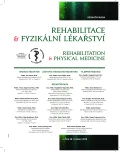-
Medical journals
- Career
Vacuum-compression therapy as part of spa treatment in post-traumatic conditions
Authors: M. Zeman 1,2
Authors‘ workplace: Zdravotně sociální fakulta Jihočeské univerzity v Českých Budějovicích, Ústav fyzioterapie a vybraných medicínských oborů, ředitelka ústavu Mgr. Petra Zimmelová, Ph. D. 1; Slatinné lázně Třeboň s. r. o. – Bertiny lázně, primářka MUDr. Ivana Zezulková 2
Published in: Rehabil. fyz. Lék., 26, 2019, No. 1, pp. 50-52.
Overview
Vacuum-compression therapy is one of the most effective mechanical therapy methods for physical therapy. Automatic alternation of the vacuum and overpressure phase in a hermetically sealed application cylinder greatly influences limb blood vessels and works in the treatment of various blood circulation, metabolism and nutrition disorders - especially in complications of diabetes, polyneuropathies, leg ulcers and post-traumatic conditions associated with swelling. In post-traumatic and postoperative conditions, the rate of regeneration and recovery of tissue energy parameters is very important and has a significant effect on the overall recovery time. The advantage of the spa environment when applying this therapy is the simultaneous action of other forms of physical therapy that potentiate its effectiveness. The paper describes the procedure and course of therapy in a patient with chronic perimaleolar swelling within 28 days of comprehensive spa treatment, where the condition was significantly improved, edema was reduced and mobility improved.
Keywords:
vacuum-compression therapy – vacuum – overpressure – blood circulation – post-traumatic condition – spa treatment – individual physiotherapy
Sources
1. AKBARI, A., MOODI, H., GHIASI, F. et al.: Effects of vacuum-compression therapy on healing of diabetic foot ulcers: Randomized controlled trial. J. Rehabil. Res. Dev., roč. 44, 2007, č. 5, s. 631-636.
2. NAKLÁDALOVÁ, M. et al.: Vakuově-kompresivní terapie v pracovním lékařství. Pracovní lékařství, roč. 66, 2015, č. 4, s. 151-153.
3. PODĚBRADSKÝ, J., PODĚBRADSKÁ, R.: Fyzikální terapie - manuály a algoritmy. Praha, Grada Publishing, 2009, s. 175-178.
4. PRŮCHA, J., KLAPALOVÁ, A., VOLEJNÍK, V. et al.: Studie typických změn periferní cirkulace při podávání procedur vakuově-kompresní terapie. Rehabil. fyz. Lék., roč. 21, 2014, č. 1, s. 28-37.
5. TICHÁČEK, J., ŠTVRTINOVÁ, V., GÚTH, A. et al.: Kvantifikace vlivu vakuově-kompresní terapie na přímé zvýšení dodávky kyslíku léčené končetině. Rehabil. fyz. Lék., roč. 20, 2013, č. 2, s. 95-108.
6. ZEMAN, M.: Základy fyzikální terapie. České Budějovice, JU ZSF, 2013, s. 75-76.
Labels
Physiotherapist, university degree Rehabilitation Sports medicine
Article was published inRehabilitation & Physical Medicine

2019 Issue 1-
All articles in this issue
- Zemřela prof. MUDr. Olga Švestková, Ph.D.
- Ergotherapy Intervention on the Bed Iincluding Early Rehabilitation Influences Self-sufficiency and Duration of Hospitalization
- Dissection of Vertebral Artery as a Complication of Manipulation Therapy
- Hand Arm Bimanual Intensive Therapy of Upper Extremities (HABIT) in Patients with Child Cerebral Palsy
- Application of Manual Lympho-drainage in Oncology
- Clinical Utility of Rivermead Behavioral Memory Test in Patients after Acquired Brain Injury
- Chronic Non-specific Low Back Pain and Yoga as One of the Treatment Possibilities
- Vacuum-compression therapy as part of spa treatment in post-traumatic conditions
- Rehabilitation & Physical Medicine
- Journal archive
- Current issue
- Online only
- About the journal
Most read in this issue- Vacuum-compression therapy as part of spa treatment in post-traumatic conditions
- Dissection of Vertebral Artery as a Complication of Manipulation Therapy
- Chronic Non-specific Low Back Pain and Yoga as One of the Treatment Possibilities
- Ergotherapy Intervention on the Bed Iincluding Early Rehabilitation Influences Self-sufficiency and Duration of Hospitalization
Login#ADS_BOTTOM_SCRIPTS#Forgotten passwordEnter the email address that you registered with. We will send you instructions on how to set a new password.
- Career

